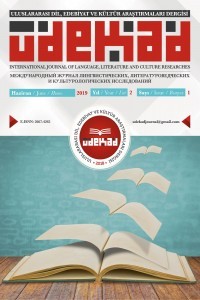EDEBİ MAĞRİBİ KADIN VE ONUN ÜÇ FARKLI DÖNEMDE TEMSİLİ: EL ABENCERRAJE, “ESİRİN ÖYKÜSÜ” VE DIARIO DE UN TESTIGO DE LA GUERRA DE ÁFRICA.
Mağribi kadın İspanyol kültürel ve edebi mirasının asli unsurdur. Bu durum farklı tarihsel dönemlerde sorgulandığında, Mağribi kadın şahsiyetinin edebi eserlerde çifte bir imgelem oluşturduğu gözlemlenmektedir. Erken dönem çalışmalarda idealleştirilen Mağribi kadın, Mağribi erkek gibi bir korkuyu tetiklemekten ziyade bir yıkıcı gücü nedeniyle aşağılanıp reddedilen bir duyguyu tetiklerken tasvir edilmektedir. Bu makalede Jarifa (El Abencerraje, 1561-1565?), Zoraida (Don Quijote’deki, “Esirin Öyküsü”, 1605) Diario de un Testigo de la Guerra de África (1859-1860)’da görülen isimsiz kadın Mağribi ve de Pedro Antonio de Alarcón gibi farklı dönemlerdeki edebi Mağribi kadınlar temel alınmıştır. Bu makale, edebi Mağribi kadın imajının nasıl inşa edildiğini ve farklı zamanlarda algısının ne şekilde değiştiğini incelemek için onların “Mağribi olmayan” kişiliklerle olan ilişkisini de göz önünde bulundurarak neredeyse idealize edilmiş bir imgelemden, insanlık dışı ve hayvanlaştırma terimlerini de içeren çok daha aşağılayıcı bir bakışa doğru yavaş yavaş evrilen bir görüşü incelemektedir.
Anahtar Kelimeler:
Mağribi kadın, Abencerraje, Esirin Öyküsü, Diario de un Testigo de la Guerra de África
THE LITERARY FEMALE MOOR AND HER REPRESENTATION IN THREE DIFFERENT PERIODS: EL ABENCERRAJE, “HISTORIA DEL CAUTIVO” AND DIARIO DE UN TESTIGO DE LA GUERRA DE ÁFRICA.
The female Moor is a fundamental element of the Spanish cultural and literary heritage. When questioning about its perception in different historical periods, it is observed that this figure represents a double vision within literature: on one hand, in early works there is a tendency to portray an apparent idealized feminine figure, while in later works she sometimes inspires a feeling, not of fear as in the case of the male Moor, but of contempt and rejection due to her disruptive force. Based on literary female Moors from different periods —such as Jarifa (El Abencerraje, 1561-1565?), Zoraida (“Historia del Cautivo” included in El Quijote, 1605) and the female Moors without a name that appear in Diario de un Testigo de la Guerra de África (1859-1860) by Pedro Antonio de Alarcón—, the present essay takes into account their relationship with the “non-Moorish” characters in order to analyze the way in which the literary female Moor is built and how its perception varies in different periods, gradually fluctuating from an almost idealized vision to a much more degrading one that includes the use of dehumanized and animalization terms.
Keywords:
literary female Moor, Abencerraje, Historia del Cautivo, Diario de un Testigo de la Guerra de África,
___
- Alarcón de, Pedro Antonio (2005). Diario de un Testigo de la Guerra de África. Madrid: Ediciones Irreverentes.
- Avilés, Luis F. (2003). “Los Suspiros Del ‘Abencerraje’”. Hispanic Review, 71 (4): 453-472.
- Bass, Laura R. (2000). “Homosocial Bonds and Desire in The Abencerraje”. Revista Canadiense de Estudios Hispánicos, 24 (3): 453-71.
- Burshatin, Israel (1984). “Power, Discourse, and Metaphor in the Abencerraje”. MLN, 99 (2): 195-213.
- Burshatin, Israel (1986). “The Moor in the Text: Metaphor, Emblem, and Silence”. Race,Writing and Difference. ed. Henry Louis Gates Jr. Chicago: University of Chicago Press. 117-37.
- Cervantes, Miguel de (2000). Don Quijote de La Mancha. Editado por Martín de Riquer. Barcelona: Editorial Planeta.
- El Abencerraje. Novela y romancero (2003). Editado por Francisco López Estrada. Madrid: Cátedra.
- Garcés, María Antonia (1989). “Zoraida´s Veil:´The Other Scene Of “The Captive´s Tale”’. Revista de Estudios Hispánicos, 22: 65-98.
- Goytisolo, Juan (1998). Crónicas Sarracinas. Madrid: Alfaguara.
- Graf, Eric Clifford (1999). “When an Arab Laughs in Toledo: Cervantes’s Interpellation of Early Modern Spanish Orientalism”. Diacritics 29 (2): 68-85.
- Hernández-Pecorano, Rosilie (2002). “Jarifa´s Choice: A Gendered Reading of El Abencerraje y La Hermosa Jarifa”. Bulletin of Spanish Studies, 79 (4): 429-46.
- Karaca, Ceren (2014). “Lope de Vega´nın Lo que hay que fiar del mundo Adlı Oyununda Türk Karakterlerin Üzerinden Hıristiyan Kimliğinin İnşası” [La construcción de la identidad cristiana a través de los personajes turcos en Lo que hay que fiar del mundo de Lope de Vega]. Tiyatro Araştırmaları Dergisi, 37: 43-57.
- León, Pedro R. (1974).“‘Cortesía’, clave del equilibrio estructural y temático en El Abencerraje”. Romanische Forshungen, 86: 255-64.
- Mirrer, Louise (1996). Women, Jews and Muslims in the Texts of Reconquest Castile, Michigan: University of Michigan Press.
- Said, Edward W. (1978). Orientalism. Londres: Routledge & Kegan Paul.
- Stoll, André (1995). “Avatares de un cuento del Renacimiento. El Abencerraje releído a la luz de su contexto literario cultural y discursivo”. Sharq al-Andalus, 12: 429-60.
- Başlangıç: 2018
- Yayıncı: Reşat ŞAKAR
Sayıdaki Diğer Makaleler
Ayfer Kafkas’ın “Esrarname” Roman Serisinde Folklor ve Kütahya Halk Hayatı
BİR DÖNEME DAMGA VURAN ÜÇ AVANGART DERGİ: LEONARDO, LA VOCE VE LACERBA
DİL EDİNİMİNDE ÖNE ÇIKAN KURAMLAR: ANALİTİK YAKLAŞIM
Osman AKTAŞ, Luay Hatem YAQOOB
Sherlock Holmes Hikayelerinde Aile İçi Şiddet ve Boşanma
İLYAS KÖYÜNDEKİ (DİYARBAKIR-ÇÜNGÜŞ) TARIM VE HAYVANCILIK İLE İLGİLİ SÖZ VARLIĞI
Tarama Sözlüğünde Bazı Yiyecek ve İçecek Adları Üzerine Değerlendirme
ERNESTO SÁBATO’NUN TÜNEL ROMANINDA SAPLANTI VE ŞİDDET
“GİBİ” SÖYLEM BELİRLEYİCİSİNİN TÜRKÇE KONUŞMA DİLİNDEKİ İŞLEVSEL KULLANIMLARI
